Henry IV, Holy Roman Emperor
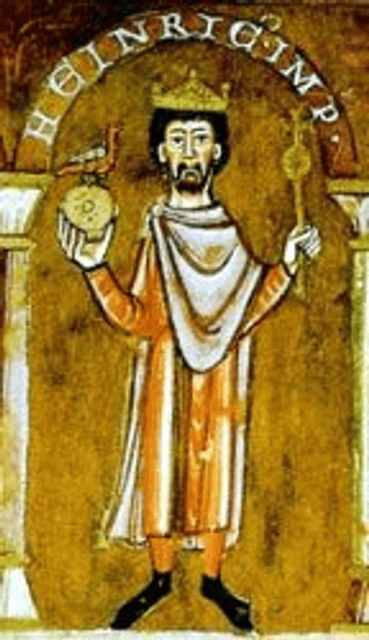
Henry IV, Holy Roman Emperor

| Henry IV | |||
|---|---|---|---|
| Holy Roman Emperor | |||
| Reign | 5 October 1056 – 31 December 1105 | ||
| Coronation | 31 March 1084 Old St. Peter's Basilica, Rome | ||
| Predecessor | Henry III | ||
| Successor | Henry V | ||
| King of Germany | |||
| Reign | November 1053 – 31 December 1105 | ||
| Coronation | 17 July 1054 Aachen Cathedral | ||
| Predecessor | Henry III | ||
| Successor | Henry V | ||
| King of Italy and Burgundy | |||
| Reign | 5 October 1056 – 31 December 1105 | ||
| Predecessor | Henry III | ||
| Successor | Henry V | ||
| Born | 11 November 1050 Imperial Palace of Goslar, Saxony | ||
| Died | 7 August 1106(1106-08-07)(aged 55) Liège, Lower Lorraine | ||
| Burial | Speyer Cathedral | ||
| Spouse | Bertha of Savoy (m. 1066 – wid. 1087) Eupraxia of Kiev (m. 1089 – div. 1095) | ||
| Issue | Agnes of Waiblingen Conrad II of Italy Henry V, Holy Roman Emperor | ||
| House | Salian dynasty | ||
| Father | Henry III | ||
| Mother | Agnes of Poitou | ||
| Religion | Roman Catholicism | ||
German royal dynasties | |||
| Salian dynasty | |||
| Chronology | |||
| Conrad II | 1024 – 1039 | ||
| Henry III | 1039 – 1056 | ||
| Henry IV | 1056 – 1105 | ||
| Henry V | 1105 – 1125 | ||
| Family | |||
| Family tree of the German monarchs | |||
| Succession | |||
| Preceded by Ottonian dynasty | Followed by Süpplingenburg dynasty | ||
Henry IV (German: Heinrich IV; 11 November 1050 – 7 August 1106) was Holy Roman Emperor from 1084 to 1105, king of Germany from 1054 to 1105, king of Italy and Burgundy from 1056 to 1105, and duke of Bavaria from 1052 to 1054. He was the elder of the two sons of Henry III, Holy Roman Emperor, and Agnes of Poitou. He was designated as his father sole heir on Christmas 1050. His father died on 5 October 1056 and the six-year-old Henry was placed under his mother's guardianship. Empress Agnes made lavish grants to the German aristocrats to secure their support. Unlike her late husband, she could not control the election of the popes, thus the idea of the "freedom of the church" spread during her rule. Taking advantage of the Empress's weakness, Archbishop Anno II of Cologne kidnapped Henry in April 1062. Anno administered Germany until Henry came of age in 1065, but Archbishop Adalbert of Hamburg gained the young King's confidence.
Henry decided to recover the royal estates that had been lost during his minority. He appointed low-ranking officials to carry out his new policies in Saxony and Thuringia. New royal fortresses were built and his officials ignored local customs and immunities. Henry crushed a riot in Saxony in 1069, and also overcame the rebellion of the wealthy Saxon aristocrat, Otto of Nordheim in 1071. Henry insisted on his royal prerogatives relating to the appointment of bishops and abbots, although the reformist clerics regarded this practice as a form of simony (a forbidden sale of church offices). Pope Alexander II blamed Henry's advisors for scandals over his appointments and excommunicated them in early 1073. Henry's conflicts with the Holy See and the German dukes weakened his position and the Saxons again rose up in the summer of 1074. He took advantage of a rift between the Saxon aristocrats and peasantry and forced the rebels into submission in October 1075.
Henry adopted an active policy in Italy. His activism alarmed Pope Gregory VII who threatened him of excommunication for simony. Henry persuaded the majority of the German bishops to declare the Pope's election invalid at their assembly at Worms on 24 January 1076. In response, the Pope excommunicated Henry and released his subjects of allegiance. To prevent the Pope from sitting in judgement on him at the German dukes and bishops' assembly, Henry went to Italy to meet with the Pope. He achieved his purpose on his "Road to Canossa", because Pope Gregory VII had no choice but to absolve him after he had humiliated himself to demonstrate his penitence. Henry's German opponents ignored his absolution and elected Rudolf of Rheinfelden king on 14 March 1077.
| Henry IV | |||
|---|---|---|---|
| Holy Roman Emperor | |||
| Reign | 5 October 1056 – 31 December 1105 | ||
| Coronation | 31 March 1084 Old St. Peter's Basilica, Rome | ||
| Predecessor | Henry III | ||
| Successor | Henry V | ||
| King of Germany | |||
| Reign | November 1053 – 31 December 1105 | ||
| Coronation | 17 July 1054 Aachen Cathedral | ||
| Predecessor | Henry III | ||
| Successor | Henry V | ||
| King of Italy and Burgundy | |||
| Reign | 5 October 1056 – 31 December 1105 | ||
| Predecessor | Henry III | ||
| Successor | Henry V | ||
| Born | 11 November 1050 Imperial Palace of Goslar, Saxony | ||
| Died | 7 August 1106(1106-08-07)(aged 55) Liège, Lower Lorraine | ||
| Burial | Speyer Cathedral | ||
| Spouse | Bertha of Savoy (m. 1066 – wid. 1087) Eupraxia of Kiev (m. 1089 – div. 1095) | ||
| Issue | Agnes of Waiblingen Conrad II of Italy Henry V, Holy Roman Emperor | ||
| House | Salian dynasty | ||
| Father | Henry III | ||
| Mother | Agnes of Poitou | ||
| Religion | Roman Catholicism | ||
German royal dynasties | |||
| Salian dynasty | |||
| Chronology | |||
| Conrad II | 1024 – 1039 | ||
| Henry III | 1039 – 1056 | ||
| Henry IV | 1056 – 1105 | ||
| Henry V | 1105 – 1125 | ||
| Family | |||
| Family tree of the German monarchs | |||
| Succession | |||
| Preceded by Ottonian dynasty | Followed by Süpplingenburg dynasty | ||
Early life
Born on 11 November 1050, Henry was the son of Henry III, Holy Roman Emperor by his second wife, Agnes of Poitou.[1][2] Historians Ian S. Robinson and Boyd H. Hill propose that Henry was born in the imperial palace at Goslar.[1][2] His birth had been long-awaited, because his father had fathered four daughters, but his subjects were convinced that only a male heir could secure the "peace of kingdom" (as Hermann II, Archbishop of Cologne stated it in a sermon).[1][3] Henry was first named for his grandfather, Conrad II, Holy Roman Emperor, but Abbot Hugh of Cluny, whom Henry III had appointed as his son's godfather, convinced the Emperor to give his name to his heir.[3] Henry's baptism was delayed, because Abbot Hugh could not immediately leave Cluny for Germany, but the ailing Henry III designated his infant son as his successor in Pöhlde (in Saxony) on Christmas 1050.[3][4] On this occasion, the Emperor also "caused many of the princes"—most probably the Saxon and Thuringian aristocrats—"to promise an oath of fidelity and submission" to Henry.[4]
Archbishop Hermann baptised Henry in Cologne on Easter day 1051.[1] The Emperor held a great assembly at Tribur in November 1051 to secure his son's succession.[5] The German princes who attended the meeting elected the one-year-old Henry king, but they stipulated that they would acknowledge him as his father's successor only if he acted as a "just ruler" during his father's lifetime.[5] Robinson supposes that the princes actually wanted to persuade Henry III to change his methods of government since the child king had no role in state administration.[6] About a month later (on Christmas 1052), the Emperor made Henry the duke of Bavaria.[3][6]
Archbishop Hermann crowned Henry king in Aachen on 17 July 1054.[6] Most probably on this occasion, Henry's two-year-old younger brother, Conrad, received Bavaria from their father.[6] When Conrad died in 1055, the Emperor gave Bavaria to Empress Agnes.[7] The Emperor betrothed Henry to Bertha of Savoy in late 1055.[8] Her parents, Adelaide, Margravine of Turin, and Otto, Count of Savoy, controlled north-western Italy and the Emperor wanted to secure their alliance against the rebellious Duke of Lower Lorraine, Godfrey the Bearded.[8]
Henry III fell ill in late September 1056.[8] When he was dying in the palace of Bodfeld, he commended Henry to Pope Victor II's protection.[9] The Pope persuaded all bishops and aristocrats who were also present at the Emperor's deathbed to confirm Henry's right to the throne.[10] The Emperor died on 5 October 1056.[10]
Reign
Under guardianship
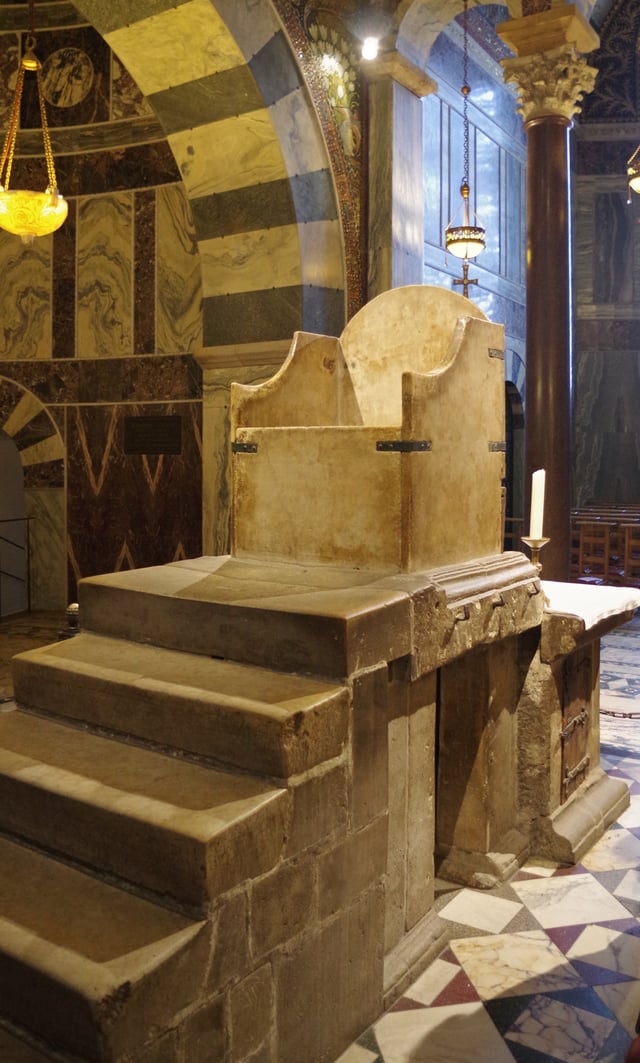
Throne of Charlemagne in the Palatine Chapel in Aachen
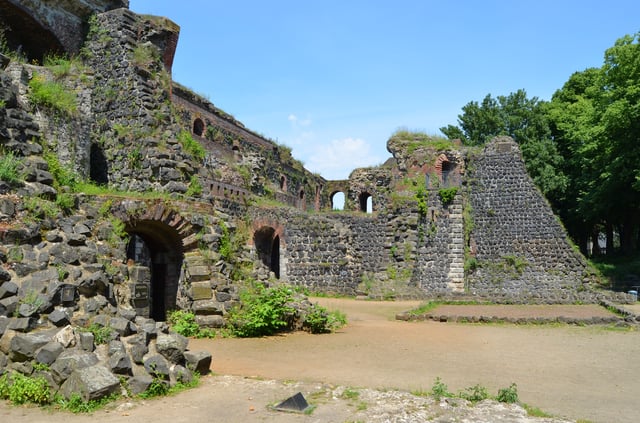
Ruins of the royal palace at Kaiserswerth: Archbishop Anno II of Cologne kidnapped Henry from here in 1062
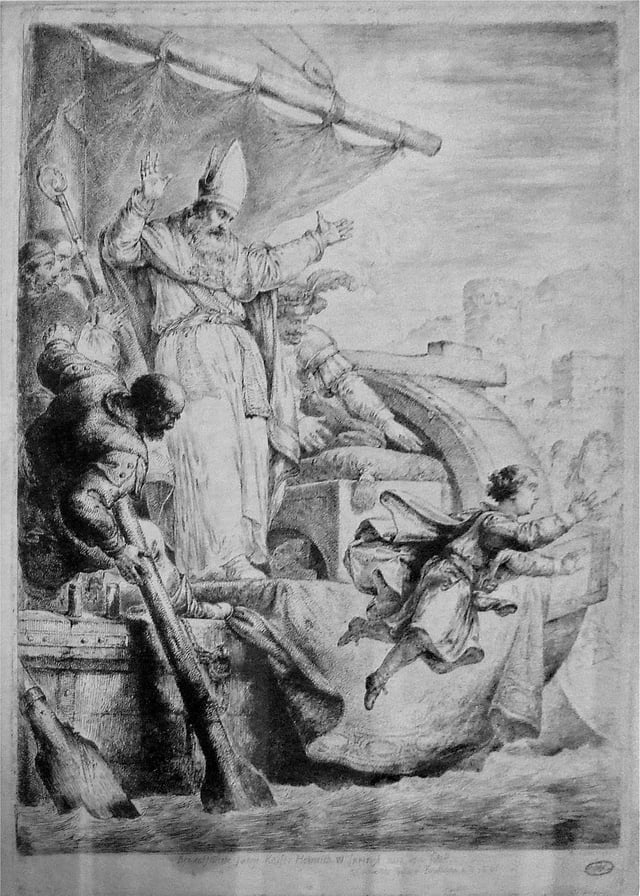
Henry jumps from Archbishop Anno II of Cologne's ship to the Rheine at Kaiserswerth in 1062
At the age of six, Henry succeeded his father without opposition.[9][10] Pope Victor II convinced the German aristocrats to swear fealty to Henry.[10] He also extracted their promise to accept the candidate of Agnes of Poitou as king in case the throne became vacant.[11] The Pope accompanied Henry to Aachen and enthroned him as king on an unknown day before the end of 1056.[12][10] Agnes was appointed to be her son's guardian, although she had been planning to enter a nunnery.[9] She was also responsible for her son's education along with a royal ministerialis (or unfree servant), Cuno.[13] She secured the most powerful aristocrats' support through lavish grants.[14] In early December, she was reconciled with Godfrey the Bearded and Baldwin V, Count of Flanders.[15] On Christmas Day, she made Conrad of the Ezzonen family duke of Carinthia, although he had revolted against her husband.[15]
Agnes took full control of state administration as regent after the Pope left Germany for Italy in early 1057.[16] She wanted to continue her late husband's policies and followed his confidants' advice,[17] but she paid little attention to Burgundy and Italy.[18] Her personal piety did not prevent her from controlling the appointment of bishops,[19] but she lost control over papal elections.[9] Henry inherited his father's title of patrician of the Romans with the right to cast the first vote on the election of the popes.[9][20] However, the reformist concept of "freedom of the church" became dominant in Rome after Pope Viktor II died in July 1057.[21] The new pope, Stephen IX—who was Godfrey the Bearded's brother—was elected without royal intervention in early August 1057, because the reformist clerics wanted to prevent their opponents to instal a pope.[22] The new Pope soon sent two legates to Germany and Agnes confirmed the election.[22]
A group of Saxon aristocrats staged a plot against Henry, fearing that he would continue his father's oppressive policies after reaching the age of majority.[23] They convinced Otto of Nordmark, who had recently returned from exile, to mount a coup and dethrone the King.[23] Henry's two relatives, Bruno II and Egbert I of Brunswick, attacked the conspirators and Bruno killed Otto, but he also was mortally wounded in the skirmish.[23]
Agnes appointed a wealthy aristocrat, Rudolf of Rheinfelden, to be duke of Swabia in 1057.[14] She also charged Rudolf with the administration of Burgundy, most probably because his extensive Burgundian domains enabled him to pacify the local nobles.[14][24] Godfrey the Bearded, who had settled in Tuscany, took possession of Spoleto and Fermo in the Papal States.[25] Rumours spread in Italy about his determination to seize the imperial crown with the Pope's help, but the Pope died unexpectedly on 29 March 1058.[25] The Roman aristocrats placed one of their number, Giovanni, Cardinal Bishop of Velletri, on the papal throne, but the reformist clerics decided to elect Bishop Gerard of Florence pope.[26][25] They sent an envoy to Germany to seek royal support and Henry "having deliberated with the princes, designated" Gerard as pope in Augsburg on 7 June, according to the Annales Altahenses.[22]
King Andrew I of Hungary sent envoys to Germany in September 1058.[28] Emperor Henry III had launched two military campaigns against Hungary to enforce Andrew I's swear of fealty, but both campaigns ended in failure.[5] Now the King wanted to secure his succession to his five-year-old son, Solomon, with German support, because he had earlier designated his brother, Béla, as his heir.[28] The Hungarian envoys and Henry's representatives concluded a peace treaty and Henry's eleven-year-old sister, Judith, was engaged to Solomon.[22][28]
The reformist clerics elected Bishop Gerard pope in Florence in December 1058.[22] He took the name Nicholas II and Godfrey the Bearded accompanied him to Rome.[22] Nicholas II's most influential advisor, the reformist monk Hildebrand was determined to strengthen the popes' authority.[29][30] The Pope held a synod in April 1059, because he wanted to approve the irregularities of his election.[31][32] The synod issued a decree which established the exclusive right of the cardinals to elect the popes.[21] Referring to Henry as "presently king and with the help of God emperor-to-be", the decree also confirmed the emperors' existing prerogatives over papal elections, but without specifying them.[33][34] A further decree prohibited lay investiture (the appointment of clerics to churches by laymen), but its scope was most probably limited to lesser church offices, because the European monarchs continued to appoint bishops without papal interference.[35][36] However, Cardinal Humbert of Silva Candida oppenly questioned the monarchs' right to participate in the appointments of bishops and abbots in his treatises against simony.[37][38] He especially condemned the prelates for receiving a ring and a crosier from the monarchs in token of their investiture, associating this practice with simony.[39]
Andrew I of Hungary faced his brother's rebellion in 1060.[40] Agnes dispatched Bavarian, Saxon and Bohemian troops to Hungary to fight against Béla and his Polish supporters, but the three armies did not coordinate their movements.[40] Béla inflicted a decisive defeat on his brother who died of his wounds.[40][28] Andrew's family fled to Germany and Béla was crowned king on 6 December.[28][40] After Béla's victory, the command of the duchies along the Hungarian frontier had to be strengthened.[40] Agnes ceded Bavaria to a wealthy Saxon lord, Otto of Nordheim, and replaced Duke Conrad of Carinthia with Berthold of Zähringen in early 1061.[41]
The relationship between Pope Nicholas II and Germany became tense for unknown reasons in early 1061.[42][43] A German synod sharply criticized the Pope and annulled his decrees.[31][43] The Pope sent an envoy to Germany, but Cardinal Stephen of San Crisogono, was not allowed to deliver the Pope's letter.[31][43] Pope Nicholas II died on 20 July 1061.[43] Hildebrand, Peter Damian and other reformist clerics achieved the election of Anselm of Baggio, Bishop of Lucca, as the new pope on 30 September, without seeking the confirmation of his election by Henry.[44][43][45] Anselm took the name Pope Alexander II.[45] The Roman aristocrats had dispatched an embassy to Henry, asking him to exercise his prerogatives as patrician of the Romans and appoint a new pope.[46] Henry convoked the Italian bishops to a synod to Basel to discuss the issue.[47] Henry attended the synod wearing the insignia of the office of patrician.[47] For the Lombardian bishops who were hostile to the reformist clerics dominated the synod, it elected one of their number, Cadalus, Bishop of Parma, pope on 28 October.[47]
The schism—the election of two Popes—divided the German clergy, with some of the bishops supporting Cadalus (now known as Antipope Honorius II), others accepting Alexander II.[45] Archbishop Adalbert of Hamburg was Honorius's most prominent supporter, while Archbishop Anno II of Cologne acknowledged Alexander as the lawful pope.[45] Empress Agnes supported Honorius, for which her advisors were excommunicated by Alexander.[32] The Empress's blatant favoritism for Bishop Henry of Augsburg and the complete failure of the Hungarian campaign had already compromised her prestige and the schism raised even more indignation.[48] Archbishop Anno, Egbert of Brunswick and Otto of Nordheim and other aristocrats who were discontented with her rule decided to deprive her of the regency.[49] Archbishop Anno, who was their leader, equipped a ship "with admirable workmanship" and sailed down the Rhine to an island near the royal palace at Kaiserswerth in April 1062.[48][50] The ship fascinated Henry, so Anno could easily talk him into a visit on it.[48] As soon as Henry stepped on the board, the ship was unmoored.[48] Fearing that his captors want to murder him, Henry jumped to the river.[48] He almost drowned, but Egbert of Brunswick rescued him.[48] The conspirators also seized the royal insignia (the royal cross and lance).[48] Henry and the royal insignia were brought to Cologne.[48]
The "Coup of Kaiserswerth" ruined the Empress's self-confidence and she retired to her estates.[50][51] Anno replaced her as the head of the government and his new title of magister (or master) shows that he also took charge of Henry's education.[52] Anno appointed his kinsmen and his friends to the highest offices.[53] He also persuaded Henry to cede one-ninth of imperial income to him and his successors to distribute it among the monasteries in his diocese.[54] Anno was determined to put an end to the schism.[13] In October 1062, the synod of the German bishops appointed his nephew, Burchard II, Bishop of Halberstadt, to start negotiations with Pope Alexander II.[55] In the same month, Peter Damian completed a treatise to defend the legality of Alexander II's election.[34] He emphasized that Henry's "right to participate in the papal elections ... is subject each time to reconfirmation by the pope".[34] Damian's argumentation implied that Henry only inherited a claim to the imperial prerogatives over papal elections and he could forfeit this claim if he did not properly exercise his prerogatives.[34] Respect for the monarchy also declined in Germany.[56] The retainers of Abbot Widerad of Fulda and Bishop Hezilo of Hildesheim ignored Henry's commands when an armed conflict broke out between them in his presence in a church Goslar in June 1063.[56][57]
Béla I of Hungary wanted to make peace with Henry to secure his throne against his nephew, Solomon, who was staying in Germany.[58] Henry and his advisors (especially Otto of Nordheim), however, insisted on Solomon's restoration to the throne and German troops invaded Hungary in August 1063.[58][59] Henry participated in the military campaign as its nominal leader, thus gaining his first experience in commanding an army.[58][59] Béla I died unexpectedly and the German army reached Székesfehérvár almost without meeting resistance.[59] Henry installed Solomon on the throne and attended the wedding of Solomon and Judith before returning to Germany.[58][60] Adalbert of Hamburg who accompanied Henry to Hungary struck up a friendship with the young king during the campaign.[58] Adalbert was mentioned as the King's "protector" in royal diplomas, showing that his position was equal to Anno's from 1063.[58]
Anno went to Italy to attend the synod of Mantua in May 1064.[61] The synod which had been convoked to put an end of the schism recognised Alexander II as pope.[61] The Pope pledged to crown Henry emperor and sent a legate to Germany to invite the young King to Rome.[62] Anno had played a decisive role at the synod, but Adalbert of Bremen took advantage of his absence to win more influence on Henry.[61][14] Modern scholars do not agree on Anno's role after his return to Germany, with some arguing that Adalbert ousted him from power,[63] others saying that Anno's position did not change before Henry reached the age of majority.[64]
First years of majority
Henry was girded with a sword in token of his coming of age in Worms on 29 March 1065.[65] According to the contemporaneous Lampert of Hersfeld, Henry attacked Archbishop Anno of Cologne with a sword soon after the ceremony and only his mother could calm him down.[66] Lampert's report is not fully reliable, but Anno was indeed ousted from the court.[67] At Worms, Henry accepted Pope Alexander II's invitation to.[62] Agnes of Poitou recovered his influence but she left Germany for Italy two months later.[68] After her departure, Archbishop Adalbert of Bremen took full control of state administration.[58] Henry's journey to Rome was postponed first till autumn, and then indefinetily, although Alexander II needed German military assistance against his opponents.[14][69] Instead of travelling to Rome, Henry visited Burgundy in June 1065.[70] The Burgundian prelates and aristocrats' diplomas show that they regarded Henry's visit as the starting date of his reign in Burgundy.[70] Henry also visited Lotharingia and granted Lower Lotharingia to Godfrey the Bearded in October.[70]
Adalbert of Bremen, in concert with the King's young friend, Werner, seized Church property and took bribes for royal appointments to the highest ecclesiastic and secular offices. They persuaded the King to grant monasteries to the most powerful prelates and princes to appease their envy.[71] Adalbert also take advantage of his influence on the king during his feud with the Saxon aristocrats, especially with Ordulf, Duke of Saxony and Ordulf's brother, Count Herman Billung.[72] Adalbert's attempts to take possession of Lorsch Abbey with force caused a scandal in late 1065.[72] Archbishops Siegfried of Mainz and Anno of Cologne staged a plot against Adalbert.[73] Otto of Nordheim, Rudolf of Rheinfelden and Berthold of Zähringen supported them.[73] The two archbishops and the three dukes convinced Henry to dismiss Adalbert from his council at an assembly at Trebur on 13 January 1066.[14][73] Anno of Cologne regained the King's favor, but thereafter Henry did not allow any of his advisors to take full control of state administration.[74]
Henry fell so seriously ill that the aristocrats started to seek his successor in May 1066.[74][75] However, he recovered and married his bride, Bertha in a month.[74][75] Before the end of the year, Prince Richard I of Capua invaded the Papal States and Agnes of Poitou returned from Rome to Germany to persuade her son to march to Italy to defend the interests of the Holy See.[76] Henry ordered the imperial troops to assemble at Augusburg in January 1067, but he dissolved his army on receiving news that Godfrey the Bearded had already launched a counter-offensive against Richard I.[76]
Adalbert of Bremen's fall debilitated German control over the northern Slavic tribes living over the Elbe.[77] The pagan Slavs attacked their Christian neighbors, killing many of them.[77] The Lutici crossed the river and plundered Hamburg.[77] Henry launched a counter-invasion and defeated them in early 1069.[77][78]
Saxon Wars

Ruins of Castle Sachsenstein, one of the royal fortresses built in Saxony in the early 1070s
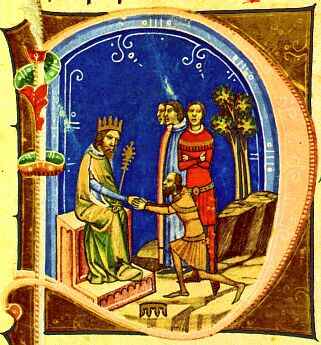
Henry's brother-in-law, King Solomon of Hungary appeals to Henry for help
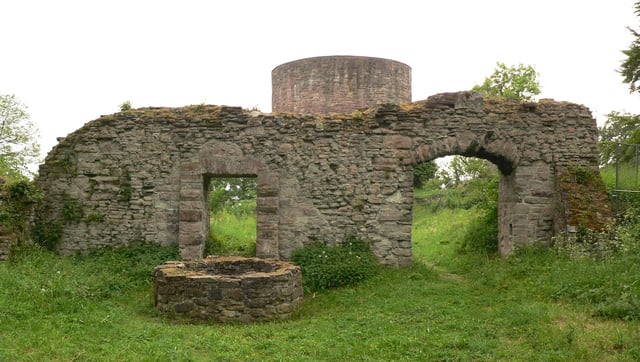
Ruins of Homburg Castle: Henry's army inflicted a decisive defeat on the Saxons near the castle in 1074
Large parcels of the royal demesne were distributed during Henry's minority, but he adopted a policy of recovery around 1069.[79] The bulk of the royal estates used to be located in Saxony.[79] Henry sent Swabian ministeriales to the duchy to carry out his new policy.[79][80] The appointment of non-native unfree officials offended the Saxons. Henry's representatives ignored the Saxons' traditional civil procedures and married into local noble families.[79][80] New castles were built in Saxony and Henry manned them with Swabian soldiers.[79][81] The Thuringians were also outraged, because Henry supported Archbishop Siegfried of Mainz's claim to collect the tithes from them.[82] The Saxon Margrave of Lower Lusatia, Dedi I, was the first to rebel.[82] He laid claim to benefices that his wife's former husband, Otto I, Margrave of Meissen, had held, but Henry refused him in 1069.[82][83] Dedi approached the Thuringians for help, but Henry's promise to confirm their exemption of tithes convinced them to join the royal army.[82] Henry invaded Dedi's domains and forced him into surrender.[82]
Otto of Nordheim held vast estates in Saxony.[79] After an adventurous nobleman, Egeno, accused him of plotting against Henry's life, Otto was summoned to "purge himself of that charge in single combat" at an assembly in Goslar on 1 August 1070.[84] Suspecting that his case would not be fairly judged, Otto fled to Saxony.[79][85] Indeed, a contemporaneous historian, Bruno the Saxon, stated that Henry had hired Egeno against Otto, but his account is biased.[85] Otto was outlawed and his benefices were confiscated, thus Bavaria returned to the Crown.[85] Henry invaded Otto's domains in Saxony and Otto plundered the royal estates in Thuringia.[85] Ordulf of Saxony remained loyal to Henry, but his son and heir, Magnus, joined Otto's revolt.[86] They defeated Henry's Thuringian supporters at Eschwege on 2 September 1070.[87] Otto's son-in-law, Welf I had inherited the large domains of the Elder House of Welf in Swabia and Bavaria.[86] To gain Welf's fealty, Henry ceded Bavaria to him on Christmas 1070.[83][87] Although Otto managed to capture Hasungen, most Saxon aristocrats remained loyal to Henry.[88] Without their support Otto and Magnus had to surrender and Henry placed them in the German princes' custody on 12 June 1071.[88]
Henry insisted on appointing the bishops and abbots, because he could demand benefices for his supporters from his appointees, but the reformist clergy regarded this practise as simony.[89] When he appointed a Milanese nobleman, Gottfried, to the Archbishopric of Milan in 1070, Pope Alexander II excommunicated Gottfried for simony.[90][91] The reformist clerics of the local Pataria movement elected one of their number, Atto, archbishop in 1072, but the townspeople prevented Atto from taking possession of Milan.[92] A papal synod declared Atto as the lawful archbishop in 1072, but Henry achieved that Gottfried was consecrated, which caused a prolonged conflict with the popes.[92] The clerics of the Bishopric of Constance appealed to the Holy See to prevent the appointment of Henry's candidate, Charles of Magdeburg, to the episcopal see in 1070.[93] The Pope ordered Archbishop Siegfried to investigate the case at a synod.[93] At the synod, which assembled in Mainz in August 1071, Henry denied that Charles had bribed him, but admitted that his advisors may have received bribes from Charles.[93] Charles had no choice but to resign to avoid the charge of simony.[93] The monks of the Reichenau Abbey also sought the Pope's support to prevent Henry from appointing an abbot to their monastery.[94] Pope Alexander II summoned the German bishops who had been accused of simony or corruption to Rome.[89]
Adalbert of Bremen persuaded Henry to release Otto of Nordheim in May 1072, but Magnus of Saxony remained imprisoned, strengthening the Saxons' views about Henry's tyrannical nature.[79][95] The appointment of low-ranking men to royal offices outraged the German aristocrats.[96] Rudolf of Rheinfelden and Berthold of Zähringen left the royal court, giving rise to rumours about an aristocratic plot against Henry.[96] Rudolf appealed to Agnes of Poitou, asking her to reconcile him with her son.[97] Agnes returned to Germany and Hugh of Cluny accompanied her.[98] She mediated a reconciliation between Henry and Rudolf in July 1072, but it proved temporary because Henry did not dismiss his advisors.[99] Rudolf and Berthold again withdraw to their duchies early in 1073, and Welf of Bavaria also left the royal court.[100] Agnes of Poitou who shared the dukes' negative views of Henry's advisors persuaded Pope Alexander II to excommunicate at least five of them in February 1073.[101][102] Henry did not break ties with his excommunicated advisors, thus breaking canon law.[103]
Pope Alexander died and the Romans proclaimed Hildebrand as his successor on 22 April 1073.[101][102] Hildebrand who assumed the name Gregory VII did not seek confirmation from Henry.[101][103] He did not challenge Henry's prerogatives, but he was convinced that a monarch who had regular contacts with excommunicated people could not intervene in Church affairs.[101][103] Henry's Italian chancellor, Bishop Gregory of Vercelli, and an assembly of the German bishops urged the King to declare Gregory VII's election invalid, but the German dukes and Godfrey the Bearded's influential widow, Beatrice of Tuscany, convinced him that he should seek a reconciliation with the Pope.[104]
Henry decided to punish Bolesław II, Duke of Poland, for his invasion of Bohemia in early 1073.[95] He ordered the Saxon aristocrats to assemble at Goslar on 29 June.[105] The Saxons refused to participate in the military campaign and requested Henry to redress their grievances.[106] They also accused Henry of debauchery and demanded that he should dismiss the "swarm of concubines with whom he slept".[107] Henry withdrew from Goslar to Harzburg without making any concessions.[106] Taking advantage of his withdrawal, Otto of Nordheim persuaded the assembled Saxons to take up arms for their liberties.[80][106] The Saxons marched to Harzburg, but Henry had fled to Eschwege.[106] The Thuringians and the Saxons concluded an alliance and captured Lüneburg.[108] To save the life of the commander of Lüneburg, Henry had to release Magnus of Saxony. The rebels acknowledged Magnus as the lawful duke of Saxony without seeking Henry's confirmation.[109] The German dukes and bishops failed to come to Henry's rescue, thus the rebels could attack the royal castles in Saxony and Thuringia.[110] Fearing that the rebellious Saxon bishops could win Pope Gregory VII over, Henry addressed a letter of penance to the Pope, admitting that he had been involved in simony.[111] He claimed that his youthful arrogance had been responsible for his sins and blamed his advisors for his simony.[112]
Siegfried of Mainz, Anno of Cologne, Rudolf of Rheinfelden, Berthold of Zähringen and other German aristocrats came to Gerstungen to start negotiations with the Saxon leaders in October 1073.[110] They tried to persuade Henry to redress the Saxons' grievances, but he was determined to crush the revolt.[110] A month later, Henry's servant, Regenger, informed Rudolf and Berthold that Henry was planning to murder them.[113] Regenger was ready to prove his words in a judicial duel, but he died unexpectedly in January 1074.[113] Henry who had just recovered from an illness moved to Worms.[113] The local bishop, Adalbert, denied his entry, but the townspeople rose up against the Bishop, forcing him to leave the town, and surrendered it to Henry.[113][114] The grateful Henry exempted the burghers of Worms of customs duties.[115]
Liemar, Archbishop of Bremen, Udo, Archbishop of Trier, and eight bishops came to visit Henry in Worms in early 1074.[113] Their retainers and the Worms militia joined Henry to a new military campaign against the Saxon and Thuringian rebels.[116] The Thuringians had laid siege to Vokenroht (an unidentified royal fortress in Saxony) where Henry's pregnant wife was staying, but they allowed her to leave the fortress for Hersfeld Abbey.[116] Henry hurried to Hersfeld, but he soon realized that the rebels outnumbered his army and entered into negotiations with them.[116] His troops were unwilling to fight, forcing Henry to accept the rebels' principal demands in the Treaty of Gerstungen on 2 February.[116] He agreed to destroy his castles and to appoint only natives to offices in Saxony in return for the Saxon aristocrats' promise to raze their newly built fortresses.[117][118] On hearing the agreement, the Saxon peasants captured and destroyed Harzburg and desecrated the graves of Henry's younger brother and first-born son.[117][119] Henry regarded their brutal action as a violation of the treaty and the destruction of the royal graves also aroused public indignation.[83][120]
Pope Gregory VII appointed the cardinal bishops Gerald of Ostia and Hubert of Palestrina to start negotiations with Henry.[121] Agnes of Poitou accompanied the two legates to her son's court.[121] After Henry did a public penance for simony, the legates absolved him on 27 April 1074.[122] They convoked the German bishops to a synod to hear the case of Bishop Herman I of Bamberg who had been accused of simony, but eight prelates did not obey their summons.[122] Henry did not intervene in the conflict between the Pope and the German prelates, although many of them had always been his strong supporter.[112] Henry's brother-in-law, Solomon of Hungary, also sent envoys to Henry, seeking his assistance against his cousin, Géza (who was Béla I of Hungary's eldest son).[123] Géza had defeated Solomon on 14 March 1074, forcing him to take refuge in the fortresses of Moson and Pressburg (now Mosonmagyaróvár in Hungary and Bratislava in Slovakia, respectively).[124] Solomon promised to cede six castles to Henry and also to acknowledge his suzerainty in return for Henry's support to recover his country.[124] Henry invaded Hungary and marched as far as Vác, but he could not force Géza into surrender.[125]
The Pope addressed two letters to Henry on 7 December 1074.[126] In one of the letters, he asked Henry to compel the eight German prelates who had not obeyed his two legates' summons to attend a synod in Rome.[126] In the second letter, he informed Henry of his new plan about a military expedition to Jerusalem for the defence of the local Christian population.[127] The second letter also referred to Henry's role as protector of the Holy See,[128] but Gregory's plan to lead an armed pilgrimage to the Holy Land clearly ignored the traditional doctrine of the Two Swords,[129] the spiritual one being held by the popes, the secular one by the emperors. The Pope's relationship with the German bishops had become tense, because he was always willing to intervene in their conflicts with their clergy.[128] Gregory VII suspended five German bishops for disobedience at the synod of Lent in Rome in February 1075.[130] The Pope also threatened Henry's five advisors with excommunication, blaming them for the prolonged conflict over the archbishopric of Milan.[130] Both Henry and the German bishops wanted to avoid a conflict.[130] Archbishops Siegfied of Mainz and Liemar of Bremen travelled to Rome to start negotiations with the Pope.[130] They acknowledged the deposition of Hermann of Bamberg and the Pope appointed Siegfried to convoke the German bishops to a synod.[130]
Henry decided to invade Saxony[123] and promised amnesty and gifts to those who joined his military campaign.[83] Most German aristocrats and bishops hurried to Breitungen where the royal troops were assembling in June 1074.[131] Saxon nobles and prelates also deserted to the royal camp, thus Henry assembled a large well-equipped army.[131] He placed it under the command of Rudolf of Rheinfelden.[131] The royal army launched a surprise attack on the Saxons at Homburg Castle on 9 June.[132] Most Saxon noblemen could flee from the battlefield, but many of the commoner foot soldiers were slaughtered.[132] Those who survived the massacre condemned the noblemen for their comrades' fate and their stories turned the Saxon peasantry against their lords.[132] Pope Gregory VII congratulated Henry for his victory, stating that the Saxons' defeat at Homburg was an act of "divine judgement".[133] In his response, Henry asked the Pope to keep their correspondence in secret, because he thought that most German dukes were keen to maintain the conflict between Henry and the Holy See.[133] However, he informed Godfrey the Hunchback, Duke of Lower Lorraine, of his correspondence with the Pope, suggesting that he did not take it seriously.[133]
Henry again invaded Saxony in autumn 1075.[134] On this occasion, Godfrey the Hunchback was the sole German duke to join his campaign, but the Saxons were unable to resist.[134] Otto of Nordheim convinced them to surrender unconditionally[117] to the King on 26 or 27 October.[134] Henry granted a pardon to Otto and returned his benefices, with the exception of Bavaria,[101] to him, but showed no mercy to other leaders of the rebellion.[135] They were imprisoned and their estates were confiscated.[136] Henry summoned the German dukes to Goslar to swear fealty to his two-year-old son, Conrad, as his successor during the Christmas celebration, but only Duke Vratislaus II of Bohemia obeyed his command.[137]
Investiture Controversy
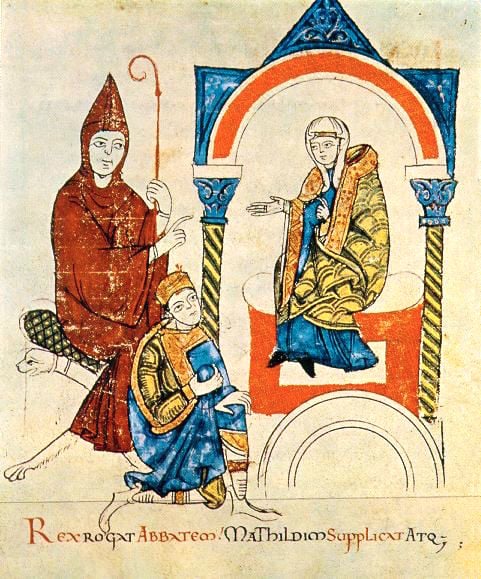
Henry begging Matilda of Tuscany and Hugh of Cluny in Canossa Castle
Henry knew that his dependence on Pope Gregory VII's benevolence weakened after his victory over the Saxons.[138][133] He sent Count Eberhard the Bearded to Italy, although Eberhard was one of his advisors whom the Pope had threatened of excommunication.[139] Eberhard outlawed the supporters of the Pataria movement (or Patarini) at the Lombardian magnates' assembly and demanded an oath of fealty from the Pope's vassal, Robert Guiscard, Duke of Apulia and Calabria.[139][140] Henry made one of his chaplains, Tedald, archbishop of Milan in clear contradiction to the Pope's former decisions.[141] Alarmed by Henry's acts, the Pope announced that he would excommunicate and deposite him unless he changes his policies.[142]
Henry regarded the Pope's words as the clear denial of his royal prerogatives.[140] He held a synod in Worms on 24 January.[143] Two archbishop, twenty-four German bishops (two-thirds of the German episcopate), one Burgundian bishop, an Italian bishop and Godfrey the Hutchback attended the meeting.[144] At Henry's order, they declared the Pope's election invalid and demanded his abdication.[143][145] An assembly of the Lombardian bishops and aristocrats passed a similar resolution in Piacenza on 5 February.[146][147] Henry's most important ally, Godfrey the Hunchback was murdered on 22 February.[147] He hurried to Utrecht and granted Lower Lorraine to his son, Conrad, ignoring Godfrey the Hunchback's appointed heir, Godfrey of Bouillon.[148]
Pope Gregory VII was informed of the decisions of the two assemblies during the synod of Lent in Rome.[143] He excommunicated Henry and released his subjects from fealty in a public prayer addressed to Saint Peter.[146][143] The deposition of a monarch by a pope was unprecedented, but the Pope was convinced that Henry's extraordinary arrogance and his loyalty to his excommunicated advisors could not otherwise be punished.[149] On learning of the Pope's decision, Henry convoked a synod to Utrecht, but the local bishop, William I, was the only prelate to be willing to excommunicate the Pope.[150] Henry's chaplain, Gottschalk, also completed a letter to be circulated in Germany which emphasized that only God could judge a king.[151] The letter addressed the Pope as the "false monk, Hildebrand" and ended with the dramatical warning: "descend, descend!"[146] Two accidents occurred in succession which discouraged Henry's supporters: a fire after a struck by lightening destroyed the cathedral of Utrecht on 27 March, and William of Utrecht died suddenly on 27 April.[151] Henry attributed the two accidents to his sins, but he did not change his mind about Gregory VII.[151]
Henry's excommunication revitalized his opponents who regarded the two accidents as divine retribution for his acts.[138][151] The German prelates did not support the excommunicated king.[149] Bishop Hermann of Metz released the Saxon rebels whom had been taken in his custody.[152] Bishop Burhard II of Halberstadt, who had been one of the leader of the Saxon revolt, escaped from captivity and returned to Saxony.[152] Two members of the House of Wettin, Theoderic and William, also returned from exile and rose up against Henry.[152] Ignoring Otto of Nordheim's advice, Henry invaded Saxony in August, but only Vratislaus II of Bohemia accompanied him.[153] Their arrival provoked a general uprising and Henry was forced to flee to Bohemia.[153] The German aristocrats and prelates had a meeting at Trebur from 16 October to 1 November.[153] They started negotiations with Henry who was staying in Oppenheim on the other bank of the Rhine and persuaded him to accept the terms that Pope Gregory VII had set for him.[154] Henry was to promise to dismiss his excommunicated advisors and to acknowledge Gregory VII as the lawful pope, furthermore he was also to acknowledge the Pope's jurisdiction in his conflicts with the dukes and bishops.[154] They soon invited Pope Gregory to Germany to hold an assembly in Augsburg on 2 February 1077.[155]
Henry moved to Speyer and lived there as a penitent.[156][157] Ignoring Gregory VII's protests, he decided to depart for Italy to receive an absolution from the Pope, because he wanted to prevent the Pope from hearing his case at an assembly dominated by his enemies.[156] Although the winter was unexpectedly severe, Henry, his wife and their retainers crossed the Mont Cenis pass in December.[158] On 25 January, they reached the Canossa Castle where the Pope had sought refuge, fearing that Henry came to Italy to capture him.[159] Henry was staying barefooted, wearing sackcloth at the castle for three days.[159] Matilda of Tuscany (who held the castle), Adelaide of Turin and Hugh of Cluny jointly convinced the Pope that he had no choice but to absolve Henry and his retainers.[159][160] Before receiving absolution, Henry had to pledge to accept the Pope's judgement in his conflict with his subjects and to grant a free pass to the Pope and his legates across the Alps.[161]
Civil war and recovery
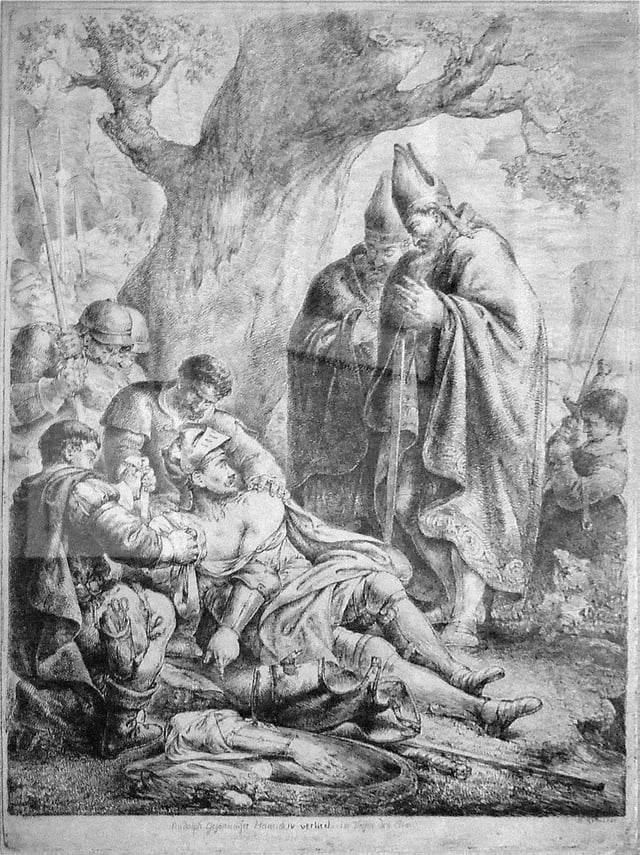
Rudolf of Rheinfelden dying after losing his right hind in the Battle on the Elster in 1080
Henry remained in Italy after his absolution and issued charters of grants to his Italian supporters, but he was not crowned with the Iron Crown of Lombardy.[162] Henry's absolution suprised his German opponents, but they held an assembly at Forchheim, arguing that Pope Gregory VII had not restored their oaths of fealty to Henry.[163] Three archbishops, four bishops, three dukes and the Saxons' representatives who attended the assembly elected Rudolf of Rheinfelden king on 14 March 1078.[164] Although the papal legates who were present acknowledged Rudolf's election, Pope Gregory VII remained neutral.[165] He maintained that he was entitled to settle the dispute and informed both Henry and Rudolf that he would hear their case at an assembly in Germany.[165]
On hearing of the election of an antiking, Henry replaced Berthold of Zähringen with Liutold of Eppenstein as duke of Carinthia and awarded Sigehard, Patriarch of Aquilea, with Friuli.[166] He also confiscated Swabia from Rudolf and Bavaria from Welf, placing both duchies under his direct control.[167] Most Bavarian aristocrats and bishops remained his loyal supporters during his war against Rudolf.[167] Before leaving Italy in April, Henry made his three-year-old son, Conrad, as his lieutenant, charging two excommunicated Italian prelates, Tedald of Milan and Denis of Piacenza, with Conrad's protection.[166] Being unable to prevent Henry's return, Rudolf of Rheinfelden had to move to Saxony, because the Saxons made up the bulk of his supporters.[168]
Henry visited Ulm, Worms, Nuremberg, Mainz, Strasbourg, Utrecht and Augsburg during the summer to demonstrate the full restoration of his royal authority.[169] He rewarded his supporters with estates confiscated from his opponents.[170] He regularly intervened in episcopal elections, appointing his own candidates to episcopal sees even if the local clergy had already elected a bishop.[171] Henry and Rudolf's armies approached each other for the first time near Würzburg in August, but Henry avoided battle, because his forces were outnumbered.[172] The aristocrats of both camps who wanted to restore peace agreed to hold a joint assembly in the absence of both kings at the Rhine in November, but Henry prevented them to start the negotiations with force.[173]
The papal legate, Cardinal Bernard, excommunicated Henry on 12 November.[174] Henry sent Bishops Benno II of Osnabrück and Theoderic of Verdun to Rome to start negotiations with the Pope whose position in Italy had meanwhile weakened.[175] The Pope appointed a new legate who celebrated Easter along with Henry in Cologne on 8 April 1078, demonstrating that the Pope had not regarded Henry's excommunication valid.[175] Henry started negotiations with the Saxons, but he did not accept their demand for exchange of hostages.[176] In May, Henry invaded Lotharingia and forced Bishop Herman of Metz into exile, because the Bishop had warned him to follow the Pope's advice.[176] Berthold of Zähringen and Welf of Bavaria inflicted defeats on Henry's Swabian and Franconian supporters in the summer.[177] Rudolf of Rheinfelden hurried to Franconia, but he met with Henry and his army of 12,000 Franconian peasants at Mellrichstadt on 7 August.[177] The Battle of Mellrichstadt proved indecisive, because both Rudolf and Henry were forced to flee from the battlefield.[178]
Pope Gregory VII prohibited all clerics from receiving royal appointments to bishoprics or abbies at a synod in Rome in November 1078.[179][180] The papal decree only threatened the clerics who had received royal investiture with excommunication, but it outlawed royal investiture.[180] Henry continued to appoint his candidates to the vacant episcopal sees and abbies, sometimes even against the will of the local clergy.[181] At the synod of Lent (in February 1079), Henry's opponents, Bishops Altmann of Passau and Herman of Metz, convinced the Pope to send new legates to Germany, but the Pope forbade his legates to pass judgement against the prelates who had been appointed by Henry.[182] Henry confiscated Rudolf of Rheinfelden's inherited Swabian estates and ceded them to Bishop Burchard of Lausanne in March.[183] In the same month, he made a wealthy local aristocrat, Frederick of Büren, duke of Swabia.[184] Frederick could take possession only of the lands north of the Danube, because Rudolf of Rheinfelden's son, Berthold, asserted his authority over the southern parts of Swabia.[185]
Henry met with the papal legates, Bishops Peter of Albano and Udalric of Padua, in Regensburg on 12 May 1079.[186] They convinced him to send envoys to Fritzlar to start negotiations with Rudolf of Rheinfelden with their mediation.[186] At the Fritzlar conference, the parties agreed to hold a new meeting at Würzburg, but Rudolf failed to appoint his representatives, because he thought that Henry had bribed the papal legates.[187] Henry launched an invasion of Saxony in August, but Rudolf persuaded the aristocrats in Henry's army to achieve Henry's consent to a truce.[187] Henry sent agents to Saxony and they convinced many Saxon leaders (including Magnus of Saxony) to desert the Antiking.[187] He also assembled troops from the German duchies, Burgundy and Bohemia and invaded Saxony in January 1080.[188] He could not surprise Rudolf who inflicted a defeat on Henry's army at Flarchheim on 27 January.[189] Rudolf could not take advantage of his victory, because the Saxons who had deserted him did not returned to his camp.[189]
Henry sent envoys to the synod of Lent to Rome and demanded Rudolf's excommunication from the Pope.[190] On 7 March 1080, the synod issued a new decree prohibiting lay investiture ordering the excommunication of the monarchs who had not abandoned this practice.[191] Pope Gregory VII excommunicated and deposed Henry and acknowledged Rudolf as the lawful king of Germany.[192] Before returning to Germany, Henry's envoys, Archbishop Liemar of Bremen and Bishop Rupert of Bamberg raised a rebellion against the Pope's principal Italian ally, Matilda of Tuscany, and secured the Lombardian aristocrats support for Henry.[193] A treatise published in Henry's defence emphasized Henry's hereditary claim to his realms.[193] The treatise, known as The Defense of King Henry, uses arguments based on Roman Law, showing that the Corpus Juris Civilis had already been studied in Italy.[193]
Henry's second excommunication was less harmful to his position than the previous ban.[194] He held a council in Mainz on 31 May 1080.[193] The nineteen German prelates and the German aristocrats who attended the council deposed Pope Gregory VII, labelling him as "the accused disturber of divine and human laws", and decided to hold a new synod to elect a pope.[193] Henry held a second synod in Brixen where nineteen Italian, seven German and one Burgundian prelates confirmed the deposition of the Pope on 25 June, accusing him of simony, heresy and a series of other sins.[195] The synod elected Archbishop Wibert of Ravenna pope.[196] Wibert assumed the name Clement III in reference to Pope Clement II (the first in the line of reformist popes to be elected through the intervention of Henry's father).[196] Henry returned to Germany and assembled his troops for a new invasion of Saxony.[197] The armies of Henry and Rudolf met at Hohenmölsen on 14 October 1080.[194][197] Henry's forces suffered a military defeat but won the battle with a strategic outcome: Rudolf was mortally wounded losing his right hand and died.[194][198] Henry took full advantage of the circumstances of Rudolf's death, describing it as a punishment for oath-breaking.[199] Henry started negotiations with the Saxon aristocrats, offering to appoint his son, Conrad, king of Saxony, but Otto of Nordheim persuaded his fellows to refuse the offer in December.[200]
Soon after, another anti-king, Hermann of Salm, arose as figurehead, but he was fought successfully by Frederick of Swabia, Rudolf's Henry-appointed successor in Swabia who had married Henry's daughter Agnes of Germany.
Second voyage to Italy
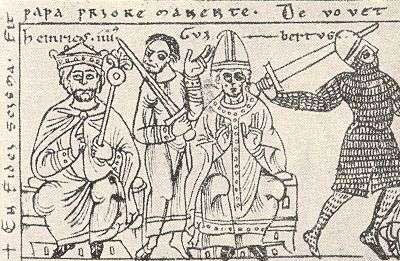
Henry IV (left), count palatine Herman II of Lotharingia (middle-left) and Antipope Clement III (middle-right), from Codex Jenensis Bose (1157)
Henry entered Pavia and was crowned as King of Italy, receiving the Iron Crown of Lombardy. He assigned a series of privileges to the Italian cities which had supported him, marched against the hated Matilda of Tuscany, declaring her deposed for lese majesty, and confiscated her possessions. Then he moved to Rome, which he besieged first in 1081: he was compelled to retire to Tuscany, however, where he granted privileges to various cities and obtained monetary assistance (360,000 gold pieces)[201] from a new ally, the eastern emperor, Alexios I Komnenos, who aimed to thwart Norman aims against his empire.
A second and equally unsuccessful attack on Rome was followed by a war of devastation in northern Italy with the adherents of Matilda. Towards the end of 1082 the king made a third attack on Rome, and after a siege of seven months, the Leonine City fell into his hands. A treaty was concluded with the Romans, who agreed that the quarrel between king and pope should be decided by a synod, and they secretly bound themselves to induce Gregory to crown Henry as emperor or to choose another pope. Gregory, however, shut up in Castel Sant'Angelo, would hear of no compromise; the synod was a failure, as Henry prevented the attendance of many of the pope's supporters, and the king, pursuant to his treaty with Alexios, marched against the Normans.
The Romans soon fell away from their allegiance to the pope. Recalled to the city, Henry entered Rome in March 1084, after which Gregory was declared deposed and Antipope Clement III was elected by the Romans.[202] On 31 March 1084 Henry was crowned emperor by Clement and received the patrician authority.[202] His next step was to attack the fortresses still in the hands of Gregory. The pope was saved by the advance of Robert Guiscard, duke of Apulia, who left the siege of Durazzo and marched towards Rome: Henry left the city and Gregory was freed. Gregory soon died at Salerno, in 1085, but not before a last letter in which he exhorted the whole of Christianity to a crusade against the Emperor.
Feeling secure of his success in Italy, Henry returned to Germany. He spent 1084 in a show of power there, where the reforming instances had still ground due to the predication of Otto of Ostia, advancing up to Magdeburg in Saxony. He also declared the Peace of God in all the Imperial territories to quench any sedition. On 8 March 1088 Otto of Ostia was elected pope as Urban II. With Norman support, he excommunicated Henry and Clement III, who was defined as "a beast sprung out from the earth to wage war against the Saints of God". He also formed a large coalition against the Holy Roman Empire, including, aside from the Normans, the Kievan Rus', the Lombard communes of Milan, Cremona, Lodi, and Piacenza, and Matilda of Canossa, who had remarried to Welf II of Bavaria, thereby creating a concentration of power too formidable to be neglected by the emperor.
Internecine wars and death
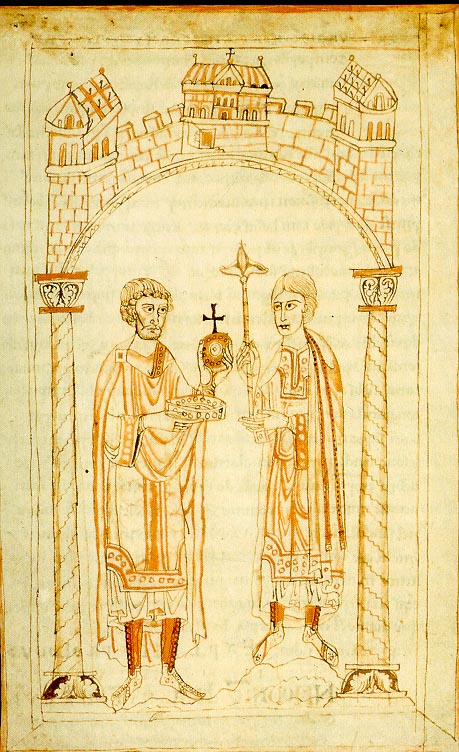
The abdication of Henry IV in favour of Henry V, from the Chronicle of Ekkehard von Aura
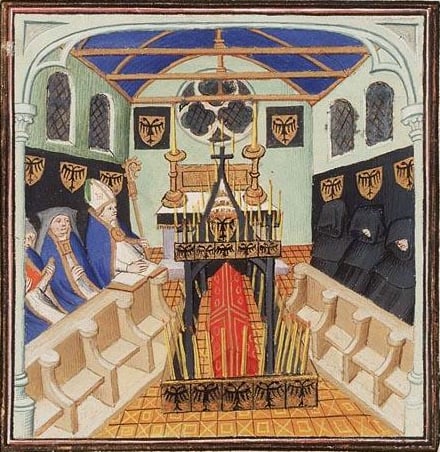
The funeral of the Emperor Henry IV
In 1088 Hermann of Salm died, and Egbert II, Margrave of Meissen, a long-time enemy of the Emperor, proclaimed himself the successor of the anti-king. Henry had him condemned by a Saxon diet and then a national one at Quedlinburg and Regensburg respectively, but he was defeated by Egbert when a relief army came to the margrave's rescue during the siege of Gleichen. Egbert was murdered two years later, in 1090, and his ineffectual insurrection and royal pretensions fell apart.
Henry then launched his third punitive expedition in Italy. After some initial success against the lands of Canossa, his defeat in 1092 caused the rebellion of the Lombard communes. The insurrection extended when Matilda managed to turn his elder son, Conrad, against him who was crowned King of Italy at Monza in 1093. The Emperor therefore found himself cut off from Germany; he was unable to return until 1097. In Germany itself his power was still at its height. Matilda of Canossa had secretly transferred her property to the Church in 1089, before her marriage to Welf II of Bavaria (1072–1120). In 1095, a furious Welf left her and, together with his father, switched his allegiance to Henry IV, possibly in exchange for a promise of succeeding his father as duke of Bavaria. Henry reacted by deposing Conrad at the diet of Mainz in April 1098, designating his younger son Henry (future Henry V) as successor, under the oath swearing that he would never follow his brother's example.
The situation in the Empire remained chaotic, worsened by the further excommunication against Henry launched by the new pope Paschal II, a follower of Gregory VII's reformation ideals, who was elected in August 1099. But this time the Emperor, meeting with some success in his efforts to restore order, could afford to ignore the papal ban. A successful campaign in Flanders was followed in 1103 by a diet at Mainz, where serious efforts were made to restore peace, and Henry IV himself promised to go on crusade. A further important constitutional move by the Hohenstaufen's was made in this year, in 1101, where a new peace mechanism for the entire empire, the Landfrieden, was issued, under Henry IV at Mainz.[203][204] This plan was shattered in 1104, however, by the revolt of his son Henry, who, encouraged by the adherents of the pope, declared he owed no allegiance to his excommunicated father. Saxony and Thuringia were soon in arms; the bishops held mainly to the younger Henry, while the Emperor was supported by the towns. A desultory warfare was unfavourable to the Emperor, however, and he was taken as prisoner at an alleged reconciliation meeting at Koblenz. At a diet held in Mainz in December, Henry IV was forced to resign his crown, being subsequently imprisoned in the castle of Böckelheim. There he was also obliged to say that he had unjustly persecuted Gregory VII and illegally named Clement III as anti-pope.
When these conditions became known in Germany, a strong dissent movement spread. In 1106 the loyal party set up a large army to fight Henry V and Paschal. Henry IV managed to escape to Cologne from his jail, finding considerable support in the lower Rhineland. He also entered into negotiations with England, France, and Denmark.
Henry was able to defeat his son's army near Visé, in Lorraine, on 2 March 1106. He died soon afterwards, however, after nine days of illness, at the age of 56, while he was the guest of his friend Othbert, Bishop of Liège. He was buried by the bishop of Liège with suitable ceremony, but by command of the papal legate he was unearthed, taken to Speyer, and placed in the unconsecrated chapel of Saint Afra, which was built on the side of the Imperial Cathedral. After being released from the sentence of excommunication, his remains were buried in Speyer cathedral in August 1111.[205]
Evaluation
Henry IV in later life displayed much diplomatic ability. His abasement at Canossa can be regarded as a move of policy to strengthen his own position at the cost of a token humiliation to himself. He was always regarded as a friend of the lower orders, was capable of generosity and gratitude, and showed considerable military skill and great chivalry.
Family
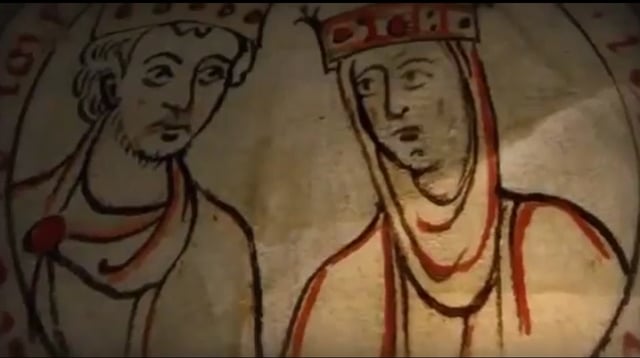
Henry IV and his wife Bertha of Savoy
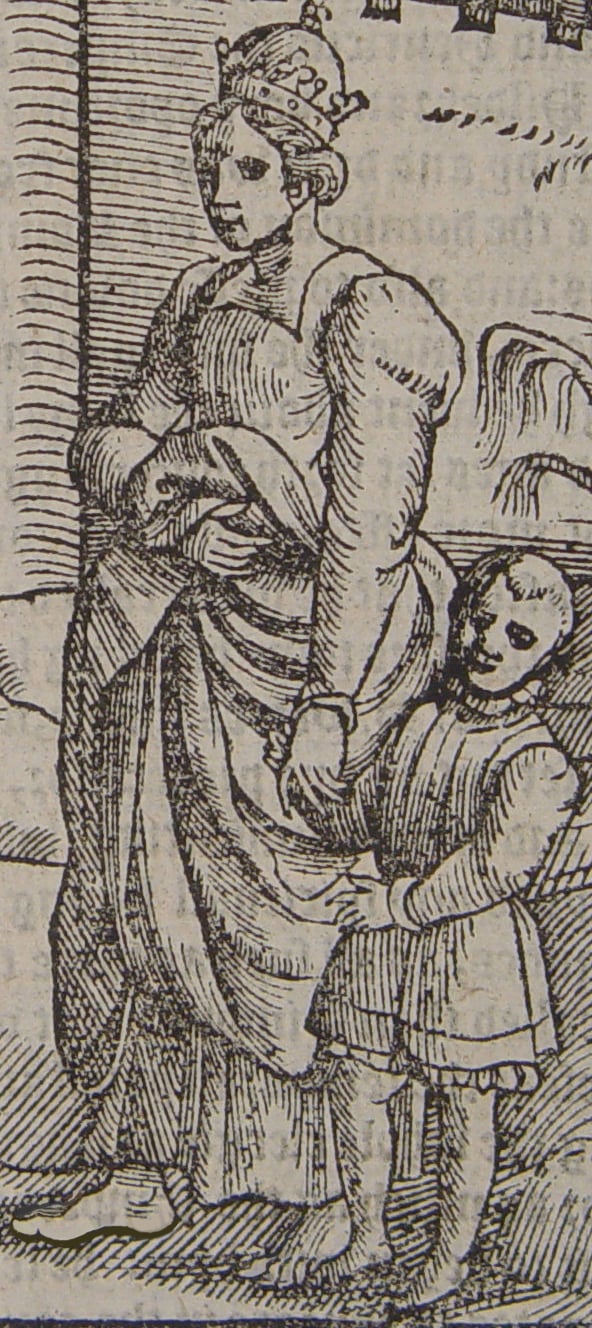
Winter 1077, the queen Bertha stands barefoot in Canossa, helping her husband beg for Pope's forgiveness
Henry's first wife, Bertha of Savoy, was bought up along with his four sisters in Agnes of Poitou's court in Germany after their engagement.[8] After their marriage, Henry regularly mentioned her as "consort of our kingdom and our marriage-bed" in his diplomas.[206] However, Henry failed to refer to Bertha after 5 August 1068, showing that he had become estranged from his wife.[207] He stated that their marriage had not been consummated at an assembly of the German princes in Worms in June 1069.[206][75] He sought a divorce from Bertha and the assembly referred his request to a synod.[208] The synod was held at Frankfurt in early October, but without passing a ruling, because Archbishop Siegfried of Mainz sought Pope Alexander II's judgement.[208] Henry's request outraged the Pope and the papal legate, Peter Damian, made it clear that Henry would never be crowned emperor if he insist on divorcing his wife.[208] Henry obeyed and Bertha was again regularly mentioned in his diplomas from 26 October 1069.[208]
Bertha died on 27 December 1087. She was also buried at the Speyer Cathedral. Their children were:
Adelheid (1070 – bef. 4 June 1079).[209]
Henry (1/2 August 1071 – 2 August 1071).
Agnes (summer 1072/early 1073 – 24 September 1143), married firstly Frederick I, Duke of Swabia and secondly Leopold III, Margrave of Austria.
Conrad (12 February 1074 – 27 July 1101), later Roman-German King and King of Italy.
Mathilde.[210]
Henry V (11 August 1081/86 – 23 May 1125), later Roman-German King and Holy Roman Emperor.
In 1089 Henry married Eupraxia of Kiev (crowned Empress in 1088), a daughter of Vsevolod I, Prince of Kiev,[211] and sister to Vladimir II Monomakh, prince of Kievan Rus.
In fiction
The title character in the tragedy Henry IVby Luigi Pirandello is a madman who believes himself to be Henry IV.
The conflict between Henry IV and Gregory VII is explored in the novel Tiara i korona by Polish writer Teodor Jeske-Choiński.
Ancestry
See also
Kings of Germany family tree. He was related to every other king of Germany.
Concordat of Worms
First Council of the Lateran